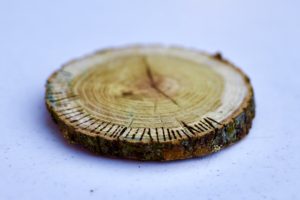
The Log Project codex opened last night at CSPS Hall with pyrography: writing in fire.
Visitors were invited to burn lines into log slices to represent their lost trees. This is the text they read before doing so:
codex, an ancient manuscript text in book form
from Latin caudex for “trunk of a tree.”
The pyrography pen before you burns into the wood with its metallic tip, a controlled conflagration.
Please draw a line vertical to the tree rings (like you see we have started) for each tree you lost to derecho. Our goal is to reach 700,000: the City of Cedar Rapids official lost tree count.
The log from which this slice comes is the only one in The Log Project without a known provenance. We collected it from the tree disposal site in Time Check last autumn, and named it the “log of unknown origin.”
Because it has no known provenance, we can all imagine it as “our tree.”
These pages will form the covers and frontispieces for the codex volumes comprised of log slices from approximately 90 logs gathered from every quadrant of Cedar Rapids — some from historically significant sites, some from personal ones.
Think about that number: 700,000—-eerily reminiscent of the COVID-19 death tally nationwide as of August 2021.
Around town, many trees are marked with the dreaded orange “x,” signifying they will be chopped down due to damage from the storm. They are, essentially, disabled.
Throughout the pandemic, hospitals have written triaging plans explicitly denying disabled people ventilators in favor of non-disabled people, and often the phrase “underlying condition” (a euphemism for disability) implies a death mattered less.
Unlike humans, trees do not dismiss sick and disabled members of their forests: Trees often even continue to feed stumps, long after the tree is dead, via their vast underground fungal networks:
… in the forest we have a social society which fights for each other, so the whole forest will survive. Every tree is interested to keep its neighbors because together they create a special climate, which is cool, which is humid, and where every tree feels comfortable.
This “first page” (or pages) of the codex is a way to meditate not only on missing our trees, but on our role in climate change — and more broadly, the larger social inequities that pandemics & climate change disasters laid bare: ableism and racism in particular, as Black people faced a death rate 3x higher than white people.
When you draw the line, you are writing in fire, and thus, the action of carving into the log slice is reminiscent of other climate change disasters where large numbers of trees are lost. During derecho cleanup, a bright red sunset over Cedar Rapids reminded us of the fires out west and the particulates spreading to our region: our deep connection to one another.
But also those particulates are implicated in worsening COVID outcomes and in COVID spread, with studies showing the particulates themselves may have some impact on contracting the virus, since we inhale them deep into our lungs.
COVID itself is linked to climate change, with zoonotic illnesses an increasing threat.
Here, all these disasters combine into one, which in essence, they already were.
